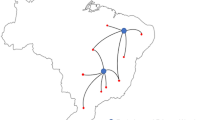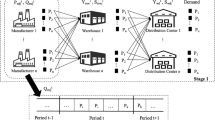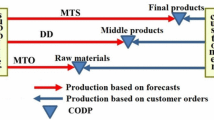Abstract
In this paper we address the production scheduling and distribution planning problem in a yoghurt production line of the multi-product dairy plants. A mixed integer linear programming model is developed for the considered problem. The objective function aims to maximize the benefit by considering the shelf life dependent pricing component and costs such as processing, setup, storage, overtime, backlogging, and transportation costs. Key features of the model include sequence dependent setup times, minimum and maximum lot sizes, overtime, shelf life requirements, machine speeds, dedicated production lines, typically arising in the dairy industry. The model obtains the optimal production plan for each product type, on each production line, in each period together with the delivery plan.
The hybrid modelling approach is adopted to explore the dynamic behavior of the real world system. In the hybrid approach, operation time is considered as a dynamic factor and it is adjusted by the results of the simulation and optimization model iteratively. Thus, more realistic solutions are obtained for the scheduling problem in yoghurt industry by using the iterative hybrid optimization-simulation procedure. The efficiency and applicability of the proposed model and approach are demonstrated in a case study for a leading dairy manufacturing company in Turkey.









Similar content being viewed by others
References
Acar, Y., Kadipasaoglu, S. N., & Schipperijn, P. (2010). A decision support framework for global supply chain modelling: an assessment of the impact of demand, supply and lead-time uncertainties on performance. International Journal of Production Research, 48(11), 3245–3268.
Ahumada, O., & Villalobos, J. R. (2011). A tactical model for planning the production and distribution of fresh produce. Annals of Operations Research, 190(1), 339–358.
Almeder, C., Preusser, M., & Hartl, R. F. (2009). Simulation and optimization of supply chains: alternative or complementary approaches? OR Spektrum, 31, 95–119.
Amorim, P., Antunes, C. H., & Almada-Lobo, B. (2011). Multi-objective lot-sizing and scheduling dealing with perishability issues. Industrial & Engineering Chemistry Research, 50(6), 3371–3381.
Amorim, P., Günther, H. O., & Almada-Lobo, B. (2012). Multi-objective integrated production and distribution planning of perishable products. International Journal of Production Economics, 138(1), 89–101.
Basnet, C., Foulds, L. R., & Wilson, J. M. (1999). An exact algorithm for a milk tanker scheduling and sequencing problem. Annals of Operations Research, 86, 559–568.
Berlin, J., Sonesson, U., & Tillman, A. M. (2007). A life cycle based method to minimise enviromental impact of dairy production through product sequencing. Journal of Cleaner Production, 15, 347.
Byrne, M. D., & Bakir, M. A. (1999). Production planning using a hybrid simulation-analytical approach. International Journal of Production Economics, 59, 305–311.
Byrne, M. D., & Hossain, M. M. (2005). Production planning an improved hybrid approach. International Journal of Production Economics, 59, 305–311.
Claassen, G. D. H., & van Beek, P. (1993). Planning and scheduling packaging lines in food industry. European Journal of Operational Research, 70, 150–158.
Doganis, P., & Sarimveis, H. (2007). Optimal scheduling in a yogurt production line based on mixed integer linear programming. Journal of Food Engineering, 80, 445–453.
Doganis, P., & Sarimveis, H. (2008a). Optimal production scheduling for the dairy industry. Annals of Operations Research, 159, 315–331.
Doganis, P., & Sarimveis, H. (2008b). Mixed integer linear programming scheduling in the food industry. In Optimization in food engineering (pp. 305–328). London: CRC Press.
Foulds, L. R., & Wilson, J. M. (1997). A variation of the generalized assignment problem arising in the New Zealand dairy industry. Annals of Operations Research, 69, 105–114.
Gellert, T., Höhn, W., & Moehring, R. H. (2011). Sequencing and scheduling for filling lines in dairy production. Optimization Letters, 5(3), 491–504.
Gnoni, M. G., Iavagnilio, R., Mossa, G., Mummolo, G., & Di Leva, A. (2003). Production planning of a multi-site manufacturing system by hybrid modeling: a case study from the automotive industry. International Journal of Production Economics, 85, 251–262.
Gunther, H.-O., & Neuhaus, U. (2004). Advanced planning and scheduling in the consumer goods industry: realizing block planning concepts for make-and-pack production using MILP modelling and SAP’s APO software. In L. N. Van Wassenhove, A. de Meyer, E. Yucesan, E. D. Gunes, & L. Muyldermans (Eds.), Operations management as a change agent (Vol. 2, pp. 757–766). Fontainebleau: INSEAD.
Hsieh, S. J. (2002). Hybrid analytic and simulation models for assembly line design and production planning. Simulation Modelling Practice and Theory, 10, 87–108.
Kim, B., & Kim, S. (2001). Extended model for a hybrid production planning approach. International Journal of Production Economics, 73(2), 165–173.
Kopanos, G. M., Puigjaner, L., & Georgiadis, M. C. (2010). Optimal production scheduling and lot-sizing in dairy plants: the yogurt production line. Industrial & Engineering Chemistry Research, 49, 701–718.
Kopanos, G. M., Puigjaner, L., & Georgiadis, M. C. (2011a). Resource-constrained production planning in semicontinuous food industries. Computers & Chemical Engineering, 35(12), 2929–2944.
Kopanos, G. M., Puigjaner, L., & Georgiadis, M. C. (2011b). Production scheduling in multiproduct multistage semicontinuous food processes. Industrial & Engineering Chemistry Research, 50(10), 6316–6324.
Kopanos, G. M., Puigjaner, L., & Georgiadis, M. C. (2012a). Efficient mathematical frameworks for detailed production scheduling in food processing industries. Computers & Chemical Engineering, 42, 206–216.
Kopanos, G. M., Puigjaner, L., & Georgiadis, M. C. (2012b). Simultaneous production and logistics operation planning in semicontinuous food industries. Omega, 40, 634–650.
Lee, Y. H., & Kim, S. H. (2002). Production-distribution planning in supply chain considering capacity constraints. Computers & Industrial Engineering, 43, 169–190.
Lee, Y. H., Kim, S. H., & Moon, Ch. (2002). Production-distribution planning in supply chain by using a hybrid approach. Production Planning & Control, 13(1), 35–46.
Lütke Entrup, M. (2005). Advanced planning in fresh food industries: integrating shelf life into production planning. Heidelberg: Physica.
Lütke Entrup, M., Günther, H.-O., Van Beek, P., Grunow, M., & Seiler, T. (2005). Mixed-integer linear programming approaches to shelf-life-integrated planning and scheduling in yoghurt production. International Journal of Production Research, 43(23), 5071–5100.
Marinelli, F., Nenni, M. E., & Sforza, A. (2007). Capacitated lot sizing and scheduling with paralel machines and shared buffers: a case study in a packaging company. Annals of Operations Research, 150, 177–192.
Nakhla, M. (1995). Production control in the food processing industry. International Journal of Operations & Production Management, 15, 73–88.
Nikolopoulou, A., & Ierapetritou, M. G. (2012). Hybrid simulation based optimization approach for supply chain management. Computers & Chemical Engineering, 47, 183–193.
Safaei, A. S., Husseini, M., Farahani, R. Z., Jolai, F., & Ghodsypour, S. H. (2010). Integrated multi-site production distribution planning in supply chain by hybrid modelling. International Journal of Production Research, 48(14), 4043–4069.
Shanthikumar, J. G., & Sargent, R. G. (1983). A unifying view of hybrid simulation/analytic models and modeling. Operations Research, 31(6), 1030–1052.
Smith-Daniels, V. L., & Ritzman, L. P. (1988). A model for lot sizing and sequencing in process industries. International Journal of Production Research, 26, 647–674.
van Dam, P., Gaalman, G., & Sierksma, G. (1993). Scheduling of packaging lines in the process industry: an empirical investigation. International Journal of Production Economics, 30, 579–589.
Yoo, T., Cho, H., & Yücesan, E. (2010). Hybrid algorithm for discrete event simulation based supply chain optimization. Expert Systems with Applications, 37(3), 2354–2361.
Author information
Authors and Affiliations
Corresponding author
Rights and permissions
About this article
Cite this article
Bilgen, B., Çelebi, Y. Integrated production scheduling and distribution planning in dairy supply chain by hybrid modelling. Ann Oper Res 211, 55–82 (2013). https://doi.org/10.1007/s10479-013-1415-3
Published:
Issue Date:
DOI: https://doi.org/10.1007/s10479-013-1415-3




